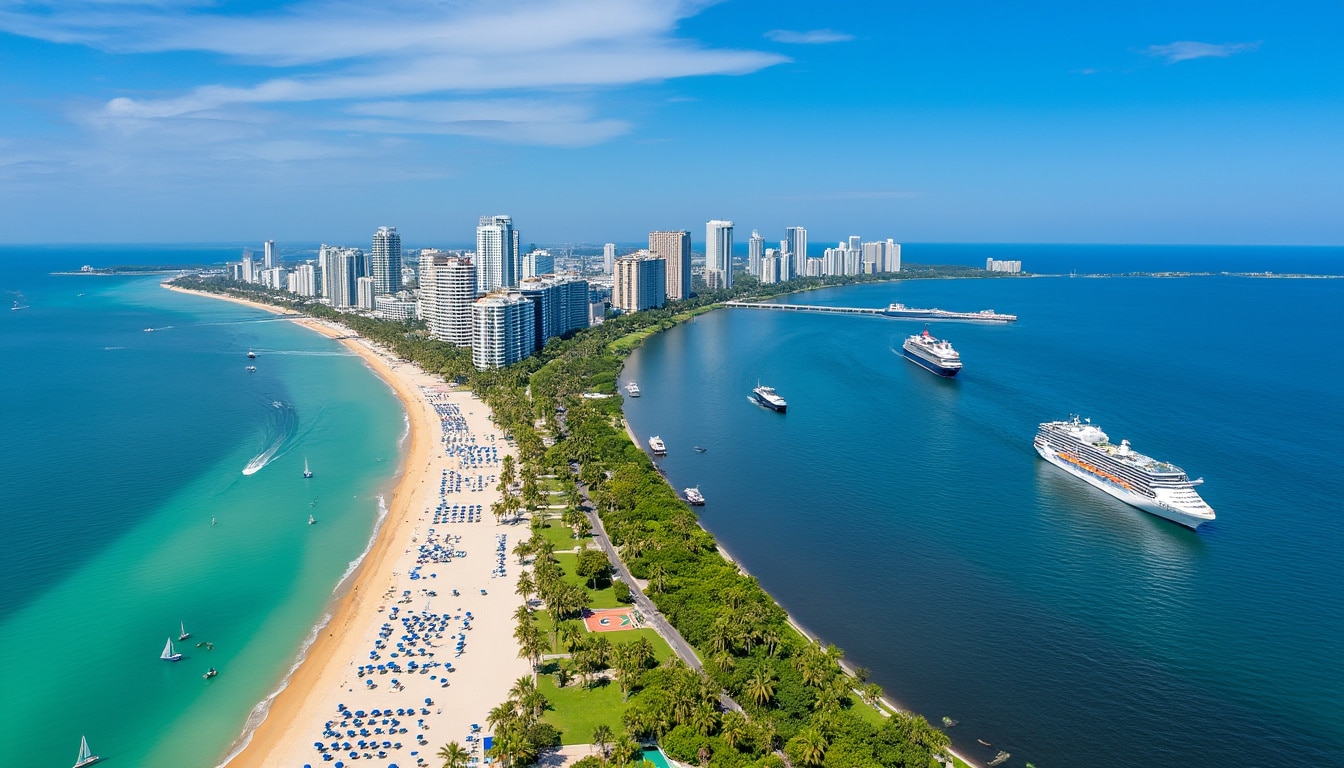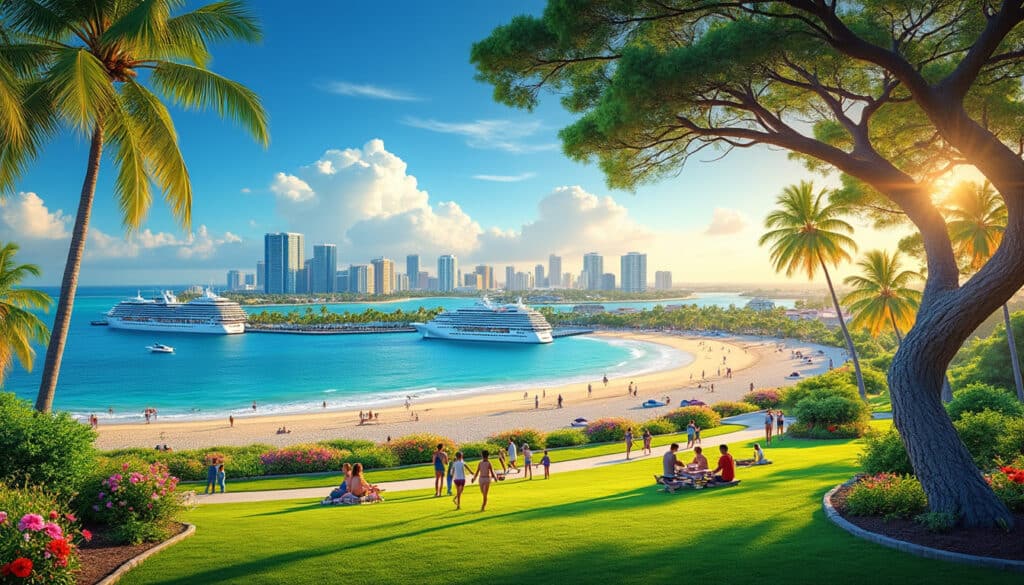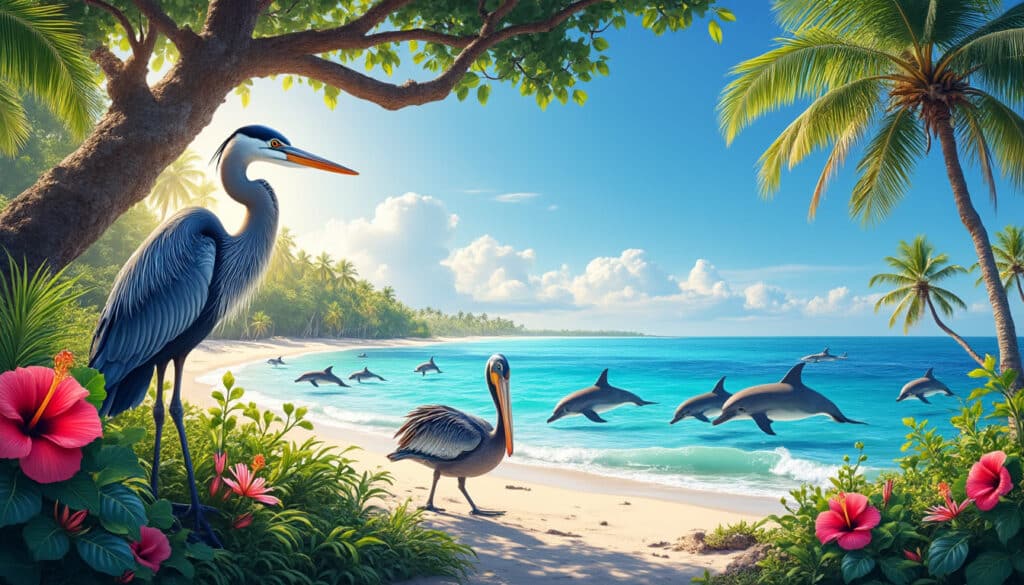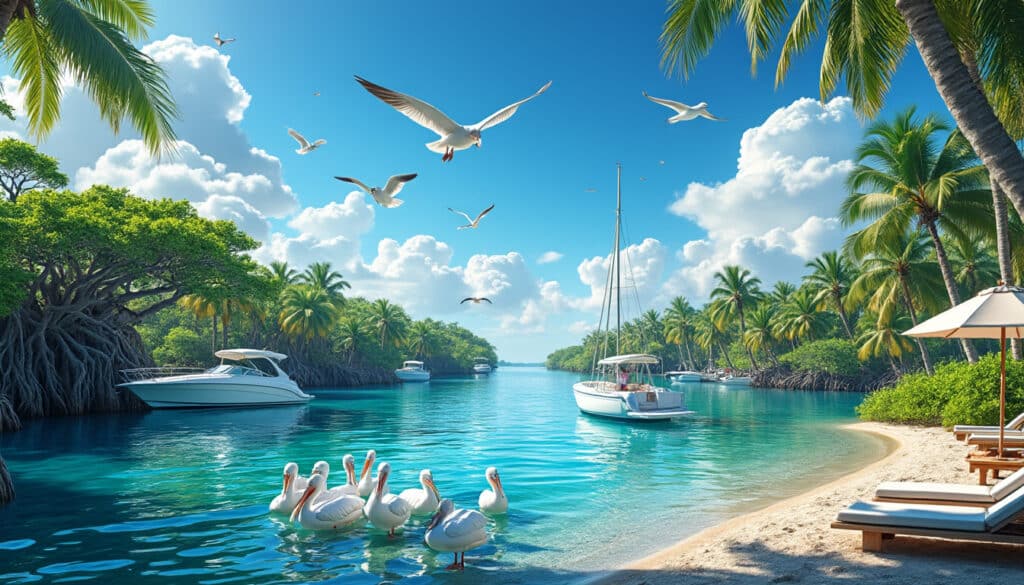🏖️ Discovering Fort Lauderdale, often referred to as the “Venice of America,” opens up a world of geographical wonders. Nestled along the Atlantic coast, this vibrant Floridian city is renowned for its intricate network of canals, sparkling beaches, and diverse environments. From the bustling Fort Lauderdale Beach to the tranquil stretches of the Intracoastal Waterway, the city’s geographical landscape invites exploration and admiration. In this detailed exploration, we delve into the captivating geographical features that make Fort Lauderdale a unique blend of urban dynamism and natural beauty.
🏞️ The Coastal Marvel: Fort Lauderdale Beach and Beyond
Fort Lauderdale’s coastline is its crowning glory, featuring sandy beaches that span seven miles along the aquamarine Atlantic Ocean. Fort Lauderdale Beach is a focal point, attracting tourists and locals alike with its stunning vistas and vibrant atmosphere. This beach is not just a place for sunbathing; it’s a cultural hub where art, music, and culinary delights converge.
The A1A Scenic Highway runs parallel to the coast, providing one of the most picturesque drives in the region. Along this route, travelers can experience a blend of natural vistas and urban scenery, with views of both the ocean and the city’s architecture. The highway leads past such notable landmarks as the Bahia Mar Resort, which is famous for its role in the city’s boating and yachting culture.
Moving beyond the beaches, Fort Lauderdale extends its natural elegance towards the Intracoastal Waterway. This navigable water route is a masterpiece of engineering that frames the city with a series of connected rivers, inlets, and bays. It offers a unique perspective on the city’s skyline and its lush landscapes, emphasizing the harmonious blend of urban life with nature. The waterway is a vibrant artery for recreational activities, with boat tours offering glimpses into the luxurious waterfront homes and the serene environment that characterizes this part of Florida.
The coastal environment influences local weather patterns, contributing to the tropical rainforest climate that defines Fort Lauderdale. With warm temperatures year-round, this climate nurtures a variety of plant and animal species along the coastline, making it a hotspot for biodiversity.

Exploring the Local Ecosystems
Fort Lauderdale’s unique position along the coast facilitates the existence of diverse ecosystems. The beaches are bordered by thriving dunes and mangrove forests that play crucial ecological roles. These natural barriers protect the shoreline from erosion and support wildlife habitats, such as nesting sites for sea turtles and migratory birds.
- 🐢 Sea turtles often nest on the beaches, with guided tours available during nesting season to educate visitors about conservation efforts.
- 🦩 The varied ecosystems provide a home for numerous bird species, making it a prime location for bird watchers and photographers.
While enjoying the charms of Fort Lauderdale Beach, visitors can also appreciate the city’s commitment to preserving its natural environments. This dedication ensures that the ecological balance between urban development and nature is maintained, allowing both to coexist and flourish.
🏙️ Las Olas Boulevard: The Heartbeat of Urban Life
Las Olas Boulevard is more than just a street; it’s the cultural heartbeat of Fort Lauderdale. Stretching from the beach to the city’s downtown core, it epitomizes the flair and sophistication of urban life. The boulevard is renowned for its eclectic array of boutiques, art galleries, and restaurants that cater to every palate.
This area showcases Fort Lauderdale’s rich architectural tapestry, blending modern high-rises with historical buildings. Notably, venues like the Riverside Hotel provide a glimpse into the city’s past, standing as a testament to the historical growth that has shaped modern Fort Lauderdale.
Las Olas also bridges the natural and urban, providing access from the bustling downtown to Hugh Taylor Birch State Park. This park, often described as the “Central Park” of Fort Lauderdale, offers a green oasis of walking trails, picnic areas, and opportunities for kayaking along its freshwater lagoon.
Las Olas Boulevard’s Cultural Offerings
The boulevard is alive with cultural offerings that reflect the city’s vibrant arts scene. Visitors can enjoy:
- 🎨 Art galleries showcasing local and international artists.
- 🎭 Theaters featuring a variety of performances from plays to live music.
- 🍷 Gourmet dining experiences with diverse cuisines and an emphasis on local seafood.
Las Olas Boulevard also comes alive during festivals and events that highlight the unique cultural landscape of Fort Lauderdale. Seasonal celebrations, art fairs, and culinary festivals bring the community together, making it an essential part of the city’s identity.
Connectivity and Accessibility
This bustling avenue is easily accessible from key locations such as the Fort Lauderdale-Hollywood International Airport and major highways, including the I-95 and I-595. Consequently, Las Olas Boulevard serves as a gateway for tourists and business travelers alike, reflecting the city’s strategic geographical positioning as a premier destination in South Florida.
🌿 Embracing Nature: Everglades and Natural Reserves
Fort Lauderdale is more than just its beaches and urban attractions. Just a short drive away lies the expansive wilderness of the Everglades National Park. This iconic park is a UNESCO World Heritage Site, famed for its incredible biodiversity and unique ecosystems.
The Everglades is home to a myriad of wildlife, including alligators, manatees, and myriad bird species. Visitors can explore this natural wonder through guided tours, airboat rides, or hiking trails, making it an unmissable adventure for nature enthusiasts.
Conservation and Education
Conservation efforts are at the forefront in Fort Lauderdale, with initiatives aimed at preserving the integrity of its natural landscapes. The city’s commitment to sustainable tourism is evident in the educational programs offered in parks like Hugh Taylor Birch State Park and the Everglades.
- 🌿 Educational tours and programs encourage visitors to engage with nature and learn about the delicate balance of ecosystems.
- 🚣 Activities such as kayaking and wildlife observation promote eco-friendly interaction with nature.
These efforts not only enhance visitor experiences but also highlight the importance of conservation in maintaining the richness of the region’s natural habitats.
🚢 The Waterways: Fort Lauderdale’s Nautical Charm
Referred to as the “Venice of America”, Fort Lauderdale boasts an impressive network of 165 miles of waterways that weave through the city. These canals carve a special niche for Fort Lauderdale, linking the city’s neighborhoods and providing unique navigation paths for boats and yachts.
Among the major waterways is the New River, which plays a crucial role in the city’s history and development. Historically, it served as a trade and transportation route, facilitating the exchange of goods and culture. Today, the river is a scenic venue for recreational activities, and its banks are lined with parks and historical sites that narrate the story of Fort Lauderdale’s past.
Yachting Capital of the World
Fort Lauderdale holds the reputation of being the yachting capital of the world, a title earned through its extensive maritime facilities. The city hosts the world-famous Fort Lauderdale International Boat Show, which attracts boating enthusiasts from around the globe.
- 🛥️ Fort Lauderdale has over 100 marinas, each bustling with activity.
- ⛵ More than 50,000 registered yachts call these waters home.
- ⚓ The New River’s connectivity with the Intracoastal Waterway and the Atlantic Ocean makes it an exceptional destination for maritime activities.
This thriving maritime industry not only defines Fort Lauderdale’s identity but also contributes significantly to its economy, supporting numerous businesses from boat manufacturing to marine services.
🏝️ Isle of Smith: A Hidden Gem
Amidst Fort Lauderdale’s bustling landscapes lies the serene Smith Island, a hidden gem lesser-known to tourists. This tranquil isle offers a retreat from the city’s lively pace, with lush vegetation and untouched beaches providing a perfect backdrop for relaxation.
Smith Island is particularly noted for its rich birdlife, which includes both residential and migratory species. The island is a perfect destination for bird watchers and photographers aiming to capture the beauty of its natural inhabitants. Hikers and nature lovers can explore the island’s trails, which provide immersive experiences among native flora and fauna.
Activities and Accessibility
While Smith Island provides a tranquil escape, access can be challenging, adding to its allure of exclusivity. Visitors can hire boats or kayaks to reach the island, embracing the opportunity for adventure while also respecting the natural environment to minimize human impact.
- 🦜 Bird watching and nature photography opportunities abound.
- 🌻 Hiking trails offer close encounters with native plant species.
- 🌊 A peaceful kayaking journey is required to access the island.
This hidden haven stands as a testament to Fort Lauderdale’s natural allure, offering peaceful solitude and adventure found less than an hour from the city’s heart.
Conservation and Protection
Efforts are ongoing to preserve Smith Island’s delicate ecosystems, emphasizing the importance of conservation and responsible tourism. The island’s pristine nature serves as both a natural paradise and a poignant reminder of the importance of protecting our most valuable resources.
In summary, the geographical features of Fort Lauderdale portray a city where urban sophistication and natural elegance coexist harmoniously. From its expansive beaches and vibrant waterways to lush parks and hidden islands, Fort Lauderdale offers a plethora of landscapes for travelers and residents to explore.
FAQs about Fort Lauderdale’s Geographical Features
| Question 🔍 | Answer ✨ |
|---|---|
| Where is Fort Lauderdale located? | Fort Lauderdale is on the southeastern coast of Florida, about 30 miles north of Miami. |
| What is the Intracoastal Waterway? | It is a series of waterways linking inland rivers with bays and the Atlantic Ocean, crucial for travel and transport. |
| How do you access Smith Island? | Smith Island is accessible by boat or kayak, offering a serene escape close to Fort Lauderdale. |
Through its natural beauty and vibrant urban environments, Fort Lauderdale stands out as a destination that promises unforgettable experiences 🏝️.

Nature and Geography of Fort Lauderdale
Discover the myriad wonders of Fort Lauderdale, a jewel nestled in southeastern Florida. Known for its extensive waterways and golden beaches, this destination offers far more than a typical coastal city experience. It holds the unique charm of vast wetlands,…

Location and coordinates of Fort Lauderdale
Discovering the dynamic blend of charming beaches, cultural hotspots, and modern landmarks in Fort Lauderdale makes it an appealing destination for both tourists and potential residents. Known as the “Venice of America,” this vibrant city has long intrigued travel enthusiasts…

Nature and wildlife in Fort Lauderdale
🌴 While many travelers flock to Fort Lauderdale for its renowned beaches and vibrant nightlife, the city’s natural wonders offer a surprisingly rich and diverse ecosystem for those seeking outdoor adventures. Nestled in the heart of South Florida, Fort Lauderdale…

Rivers and water near Fort Lauderdale
Fort Lauderdale, often dubbed the “Venice of America,” is a sun-drenched paradise renowned for its intricate network of rivers and waterways. With approximately 3,000 hours of sunshine each year, the city offers a treasure trove of aquatic adventures and scenic…

